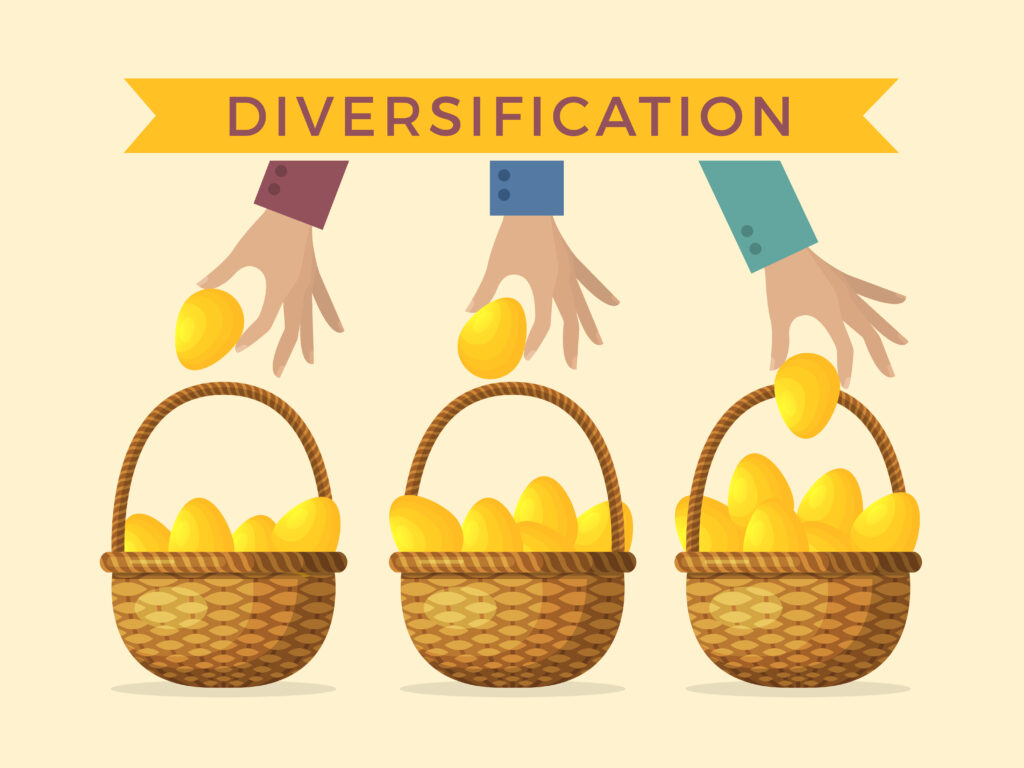When it comes to investing, the saying “Don’t put all your eggs in one basket” couldn’t be more apt. Portfolio diversification is a fundamental strategy that aims to balance risk and reward by spreading investments across a variety of assets. By diversifying your portfolio, you can optimize your chances of achieving long-term financial success while mitigating potential losses. In this blog, we’ll delve into the benefits of portfolio diversification and explore why it’s considered a cornerstone of prudent investing.
What is Portfolio Diversification?
Portfolio diversification refers to the practice of spreading investments across different asset classes, sectors, industries, geographical regions, or investment strategies to reduce risk and increase the potential for returns. It is based on the principle of not putting all your eggs in one basket.
When you diversify your portfolio, you aim to minimize the impact of any single investment on your overall portfolio performance. By allocating your investments across various assets, you create a balance that helps reduce the potential negative effects of market volatility, economic fluctuations, or unexpected events that could impact a specific investment.

Diversification can be achieved in several ways, including:
- Asset Class Diversification: Investing in a mix of asset classes, such as stocks, bonds, real estate, commodities, and cash equivalents. Each asset class has different risk and return characteristics, which helps to spread risk and capture opportunities across different market conditions.
- Sector and Industry Diversification: Investing in companies across different sectors and industries. This helps to reduce the risk of being heavily exposed to a single sector or industry that may underperform due to specific economic or market factors.
- Geographical Diversification: Investing in different countries or regions around the world. This helps to mitigate risks associated with a particular country’s economic, political, or regulatory factors, and provides exposure to growth opportunities in different markets.
- Investment Strategy Diversification: Employing various investment strategies, such as value investing, growth investing, or income investing, within your portfolio. This allows you to capture different market trends and benefit from a mix of investment styles.
The goal of portfolio diversification is to create a well-balanced investment portfolio that maximizes returns for a given level of risk or minimizes risk for a desired level of return. By diversifying, investors aim to achieve a smoother investment journey, reduce the potential for significant losses, and increase the likelihood of achieving long-term financial goals.
It is important to note that diversification does not guarantee profits or protect against losses. It is a risk management strategy that aims to improve the overall risk-return profile of a portfolio. The specific approach to diversification will depend on an individual’s investment objectives, risk tolerance, and time horizon. Regular monitoring and periodic rebalancing of the portfolio are also essential to maintain the desired diversification levels as market conditions and investment performances evolve over time.
Benefits of Portfolio Diversification
Portfolio diversification offers several benefits to investors. Here are some key benefits:
- Risk Reduction: One of the primary advantages of portfolio diversification is risk reduction. By allocating your investments across different asset classes, sectors, or geographical regions, you decrease the likelihood of a single event significantly impacting your overall portfolio. For example, if you invest solely in a single company, industry, or country, your portfolio becomes vulnerable to the specific risks associated with that entity. However, by diversifying across various investments, you can shield yourself from the adverse effects of market volatility, economic downturns, or company-specific setbacks.
- Enhanced Return Potential: While the primary aim of diversification is risk mitigation, it can also enhance your portfolio’s return potential. By investing in a range of assets with different risk-return characteristics, you have the opportunity to capture gains from various sources. For instance, during periods of market uncertainty, assets such as government bonds or gold tend to perform well as investors flock to safe-haven investments. On the other hand, during times of economic growth, stocks and equities may offer greater returns. Diversifying your portfolio allows you to participate in different market trends and potentially benefit from positive performance in specific asset classes.
- Smoothing Out Volatility: Volatility is an inherent feature of financial markets. By diversifying your portfolio, you can help smooth out the ups and downs associated with individual investments. Different asset classes, such as stocks, bonds, real estate, and commodities, often exhibit varying levels of volatility. When one asset class experiences a decline, another may be performing well, offsetting losses and reducing overall portfolio volatility. This smoothing effect can help you maintain a steadier financial journey and instill greater confidence in your investment strategy.
- Opportunity for Passive Investing: Diversification is particularly advantageous for those who prefer a passive investment approach. Instead of actively managing individual securities or trying to time the market, diversification allows you to create a well-rounded portfolio that aligns with your risk tolerance and investment goals. Through diversified index funds, exchange-traded funds (ETFs), or mutual funds, you can gain exposure to a wide range of assets instantly. This passive approach eliminates the need for constant monitoring and trading, making it an ideal strategy for long-term investors.
- Flexibility and Adaptability: As the financial landscape evolves, so too should your investment strategy. Diversification provides you with the flexibility to adapt to changing market conditions and capitalize on new opportunities. By periodically rebalancing your portfolio, you can ensure that your asset allocation aligns with your investment objectives and risk tolerance. Additionally, diversification allows you to take advantage of emerging sectors, industries, or regions that show promise for future growth, while minimizing the potential impact of any individual investment.
- Protection against Inflation: Inflation erodes the purchasing power of money over time. Diversifying your portfolio can help protect your investments against the impact of inflation. Certain asset classes, such as real estate and commodities like gold or oil, have historically shown the ability to maintain or increase their value during inflationary periods. By including these assets in your diversified portfolio, you can potentially safeguard your wealth and maintain your standard of living.
- Capital Preservation: Preserving capital is a crucial goal for many investors, especially those with a lower risk tolerance or nearing retirement. By diversifying across different asset classes, you can mitigate the risk of significant losses in any single investment. While some assets may experience downturns, others may provide stability or even appreciation, ensuring that the overall value of your portfolio remains relatively intact.
- Psychological Benefits: Investing can be an emotional roller coaster, particularly during volatile market conditions. Diversification can offer psychological benefits by reducing the emotional impact of short-term market fluctuations. When your investments are spread across multiple assets, a decline in one area is less likely to trigger panic or lead to impulsive decision-making. Diversification provides a sense of security and peace of mind, allowing you to stay focused on your long-term investment objectives.
- Access to Different Investment Opportunities: Diversifying your portfolio opens the door to a wide range of investment opportunities. Each asset class has its unique characteristics, risks, and potential returns. By diversifying, you can tap into opportunities that may not be available if you solely focus on a single asset class or investment strategy. This access to diverse investments can enhance your ability to capture potential growth and capitalize on emerging trends.
- Reduced Dependence on a Single Investment: Relying on a single investment for your financial success is a risky proposition. By diversifying, you reduce your dependence on any one investment and avoid overexposure to a particular company, industry, or sector. This reduces the impact of unforeseen events, such as a company’s bankruptcy or industry disruption, on your overall portfolio. Diversification ensures that the performance of your investments is not solely tied to the success or failure of a single entity.
Conclusion
Portfolio diversification is a powerful tool that helps investors strike a balance between risk and return. By spreading investments across different assets, sectors, and geographies, you can reduce the impact of any one investment on your overall portfolio. The benefits of diversification include risk reduction, enhanced return potential, volatility smoothing, passive investing options, and adaptability to changing market conditions. Embracing portfolio diversification as part of your investment strategy is a prudent approach that can maximize your chances of long-term financial success.






